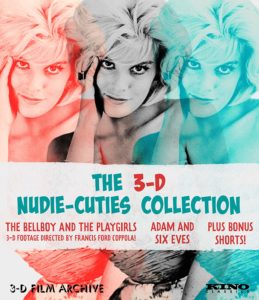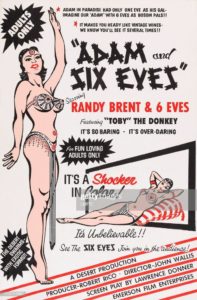Kino Lorber, the 3-D Film Archive, and Francis Ford Coppola Release the Girls
DIRECTED BY FRITZ UMGELTER, FRANCIS FORD COPPOLA/1962
BLU-RAY STREET DATE: OCTOBER 29, 2019/KINO LORBER (Part of the “3-D Nudie-Cuties Collection”)

nudie-cutie (plural nudie-cuties): A film in which cute, mischievous young women are portrayed nude; a popular genre of the 1960s.
That’s the definition of the very specific and somewhat notorious “nudie-cutie” niche of films from circa sixty-plus years ago. But, a few issues with that definition must be rectified… First: “nude” isn’t really accurate. Though the unclothed gratuitous showcasing of willing female exhibitionists and models was the primary (okay, the only) appeal of these otherwise shoddy and stupid movies, the nudity never really went below the belt. Maybe a rear end here and there, that’s it. (For the record, no sexual contact or intimate contact of any kind ever occurs in these films). Most look and feel like they were shot in two days in a spare room in a warehouse somewhere- and they probably were. Whatever budget remained after the purchase of film stock must’ve all gone to the models. But a second point of order: Was this really a popular “genre” back then? I’d argue that the nudie-cutie was never popular-popular. How could it be when admission of having gone and seen one of these “nudie-cuties” would likely prove too embarrassing? Being relegated to the raincoat crowd in the decade of Leone, Bond, and The Beatles would be a mark to be avoided.
Yet, on a related note, happening upon The Bellboy and the Playgirls in a book ostensibly all about “films no critic will review” read to this critic as a challenge. Between the fact that it is partially directed by a twenty-two-year-old Francis Ford Coppola (who in less than a decade will have made The Godfather) and the fact that the film is being released on Blu-ray by Kino Lorber… Well, here we are.
According to Wikipedia, “The film is a re-edited version of a German film of 1958 originally titled Mit Eva fing die Sünde an [The Sin Began with Eva]”, directed by Fritz Umgelter. This jibes with Coppola’s own recollection, that he was hired to shoot supplemental material in the stereoscopic Optavision process to jazz up a “stupid German movie”. And by all accounts, Mit Eva fing die Sünde an does indeed appear to be pretty ghastly in its stupidity. But even still, one might be surprised to hear that Umgelter’s commandeered black & white footage (prominently featuring Karin Dor of later Topaz and You Only Live Twice fame) is still better directed than Coppola’s tossed-off color/3-D insert nonsense.

There are two main tracks of “story” alternating the entire time. One is about a young, proper & modest actress (Dor) being talked at by her older male producer about the history and virtues of polyamory and free love. (In a post-Weinstein era, doesn’t this just sound extra swell??) Accompanying this most dated and weighted moral debate are a series of imagined interstitials, featuring the same actors imagined into chintzy historic scenarios. The paint’s barely dry and the scenery panels aren’t securely set, but that won’t stop this terrible run of amateur randiness. In an Arthurian-era medieval sequence, the line, “The chaste maid gets tired of never being chased” is actually spoken.
The other main story track involves a wacky hotel bellboy (whom no amount of online digging has yielded a definitive match of the actor’s real name with this role, although the best bet is that this is Don Kenney) who’s aspirations to become a hotel detective lead him into a litany of cheesecake misadventures. He decides that the pursuit of girls must be his true quest. (“Only by understanding women can I understand [fill in the blank]!”
This guy is a self-declared master of a thousand facial expressions- and he makes sure to use every one of them in all of his direct addresses to the camera. There are hambone performances, and then there’s this one. With him, amusement quickly gives way to irritation and annoyance, but when he’s not on screen, the movie fails to become any more palatable. Perhaps if the girls were allowed to be funny as opposed to just eye candy, this guy wouldn’t have to carry the brunt of the comedic appeal.
Carrying the brunt of the film’s advertising is June Wilkinson (here credited as “June Wilkenson”), a woman so well-endowed that her IMDb bio rhapsodizes about her extreme measurements, saying that her “contours filled out a 5′ 6″ frame that rivaled Jayne Mansfield and Mamie Van Doren during the heyday of the pneumatic blonde bombshell.” It was also the swingin’ Playboy era, which goes a long way in explaining the light-as-a-feather-boa tone and tenor of films such as this one. Reportedly, upon discovering her as a dancer and then featuring in her magazine several times, Hugh Hefner dubbed her “The Bosom”. Unlike the other titular playgirls, Wilkinson (playing a version of herself, managing a traveling group of immodest lingerie models) gets to actually act in the film, with dialogue, a name, and everything. Despite the advertising’s hyperbolic boast that the 3-D technology will put “a girl in your lap”, with her full-figured image right there alongside it, she is never featured sans her fancy robes in this movie.

Coppola once described himself as the rare film student who was willing to work in cheap exploitation cinema (often to the mockery of his classmates), having already made his own nudie-cutie, Tonight for Sure (1962), and a year away from his Corman-funded breakout horror film, Dementia 13. Coppola’s color sequences were shot by classmate and future cult filmmaking icon Jack Hill (Spider Baby, Foxy Brown). Young Coppola reportedly got $250 for his few days work; Hill got twenty-five bucks. Watching his humble, tossed-off work in Bellboy, there is zero indication that this filmmaker would not only go on to make an unmatched string of powerhouse hits throughout the 1970s, but would be one of American cinema’s grandest megalomaniacs.
The wobbly structure of the film is enough to make one legitimately wonder if this is an actual movie or not. If not, what the heck is it? Ostensibly, The Bellboy and the Playgirls is a comedy. But is it funny? No, it is not. It has “Bellboy” in the title, instantly evoking Jerry Lewis’s 1960 comedy of that very title. But is Jerry Lewis in this? No, he is not. Aggressively unfunny and even grating, this patchwork foray into lopsided gender politics had to seem antiquated even then.
You emerge from this feeling not like you just watched a movie, but that you just put up with something for ninty-four minutes. There’s exhaustion at the end of The Bellboy and the Playgirls, the kind that signals that one’s morbid curiosity has gotten the best of them. But there is a silver lining! Only by enduring this early work-for-hire exploitation gig can one truly know the degree to which Francis Ford Coppola arose in his directorial prowess.
About the Blu-ray set…

Kino Lorber’s release of The 3-D Nudie-Cuties Collection also includes the one-hour cornball indulgence Adam and Six Eves, also from 1962. In it, a bumbling lummox called Adam (Randy Brent, in flip flops and a straw hat) is extensively making his way through the desert with his put-upon donkey, Smiley, in search of gold. Instead, and he finds six giggly beauties who spend their days giggling and frolicking in billowing loincloths and not much else. There doesn’t seem to be a lot blatant 3-D opportunizing going on, though at point one girl swings on a flowered swing towards the camera, presumably offering a little somethin’-somethin’ for foot fetishists.

Obviously shot without sound, the whole thing is narrated by the the disgruntled donkey, who’s litany of observations includes Borscht Belt nuggets such as “Whoever designed her outfit ought to be placed in charge of government spending!“, and, “The natives were more determined than ever to keep Adam from the treasure. But they had little on Adam. In fact, they had little on, period!” Indeed, aficionados of the nudie-cutie consider this film (not The Bellboy and the Playgirls) among the very best of the niche. It’s a silly, plotless showcase of vibrant color, charming girls, and yes, au naturel breasts in nearly every shot. They dance, they play on the swing, they smile… If not for the near-constant nudity, this could almost be a children’s film. Apparently, this dopey bit of fluff was shot with the “venerable Natural Vision camera rig”, but never released in 3-D (until now, presumably). It’s not saying much, but if this set has a standout offering, it has to be Adam and Six Eves.
Aside from that, there are two “short films”, the first of which doesn’t register as a proper “film” at all. 1951’s “Beauty in 3rd Dimension”, which is just a three-minute array of full color 3-D glamour nudes (Ahem… “Figure studies”) as viewable through a novelty stereoscopic viewing device. The other is a ten-minute plotless dance reel of exotic dancer Bella Starr called “Love for Sale”. It’s about as risqué as the famous dance number out of the MGM Astaire film The Band Wagon but lacking any of Minnelli’s vision.
All material included on this collection is available in both 2-D and 3-D. The choice is ever more ideal, since 3-D televisions are now considered a failed technology. That said, the stereoscopic restoration work of the 3-D Film Archive is what justifies this release. Even in 2-D (as they were viewer for this review), everything on this one-disc Blu-ray set looks and sounds astonishingly well, considering the cheap-o and disposable nature of these films.

If nothing else, Kino Lorber’s 3-D Nudie-Cuties Collection offers an increasingly rare glimpse back to a time in which female movie nudity could be distilled to its base appeal, and then displayed accordingly. Forget the male gaze, this is the big dumb happy male stare. The models/actresses aren’t necessarily humiliated, just reduced to posed, living scenery. Thoroughly patriarchal in spirit, the leering quality of these films offsets any supposed innocence and body positivity that they are said to exude. It’s important to remember that a generation of men who came of age soaking up movies like this are still alive, well, and running an inordinate number of things. Likewise, the generation of women who were content to make men’s pleasure their own pleasure continue to stand by these men, ever second fiddles, even as their men’s eyes wander for younger “cuties”. The women in these movies have nothing at all to be ashamed of, though the filmmakers have a few things to answer for, both artistic and cultural. Even in 2-D, the jiggly, floppy gender politics of it all can’t help but jump off screen.
The images in this review are not representative of the actual Blu-ray’s image quality, and are included only to represent the film itself.


